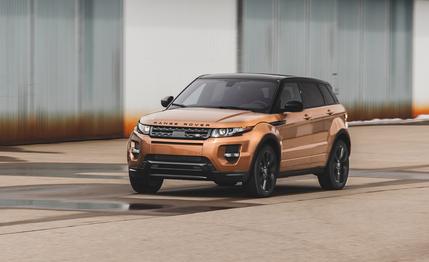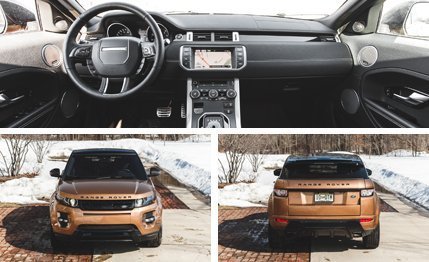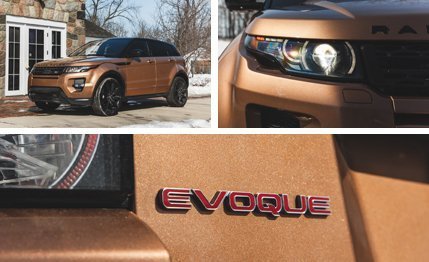 Instrumented Test
Instrumented Test
The 2014 Evoque is very much like the one that scored style points following its 2012 introduction, including North American Truck of the Year honors. But there’s one key distinction: The 2012 Evoque apportioned power to its wheels via a six-speed automatic transmission. The ZF automatic in the 2014 model adds three more cogs, spreading the power with nine forward gears.
With no change in output from the Evoque’s 2.0-liter turbo four (240 horsepower, 250 lb-ft of torque), what would you expect from this upgrade? Improved EPA fuel economy ratings? Check. Improved real-world fuel economy? Hmm. Improved performance? Not so much.
The Mass Factor
In our March 2013 issue, the six-speed Evoque squared off against an Audi Q5 2.0T and BMW X3 xDrive28i in a battle of entry-luxury compact SUVs. It did not prevail against the Teutons, but its acceleration times were competitive. Oddly, the 2014 Evoque wouldn’t have fared so well. Despite the new nine-speed and a shorter final-drive ratio, this Evoque is a smidge slower in every giddyup data point—6.9 seconds to 60 versus 6.6, 5.3 seconds 50–70 versus 4.7, and 15.4 seconds at 91 mph in the quarter versus 15.1 at 92.
So what’s the problem? Could it be curb weight? Very possibly. At 4117 pounds, the 2014 Evoque we tested is 105 pounds heavier than the 2013 model that previously graced our scales.
The nine-speed does give the new Evoque an advantage in the EPA’s testing cycle, where it’s rated at 21 mpg city, 30 highway. The EPA predicted 20/28 for the 2013 model. However, we logged just 19 mpg with the 2014 Evoque, versus 22 in the comparo. We attribute this disparity to our thorough exploration of the nine-speed’s operating parameters.

Kudos and Quirks
The new transmission may have more gears, but that alone doesn’t guarantee drive-quality improvements. Unhappiest of its traits is a reluctance to kick down several ratios when the driver nails the accelerator. This isn’t an issue in normal cruising; under part throttle, the transmission upshifts and downshifts almost imperceptibly, easily handling hills and downgrades in stride. But when the driver demands big passing power, entailing multiple downshifts, the nine-speed takes its sweet time acting on the order. The net result is a considerable lag in response, not what you want for back-road passing situations.
Employing the paddle shifters eliminates this problem. Shift time isn’t as instantaneous as some of the top dual-clutch systems, but it is quick enough to satisfy most. However, unless the dial-a-gear shift selector is in Sport mode, the transmission’s brain simply ignores commands from the paddles. Also, the nine-speed will automatically upshift about 500 rpm short of redline.
On the upside, in addition to smooth operation in ordinary use and improved EPA mileage ratings, the new ZF box employs every cog that’s in there, up to and including ninth. This hasn’t been true of other nine-speeds we’ve encountered (read: Jeep Cherokee), where ninth simply refused to engage. At 80 mph in top gear, the Evoque’s turbo four is pulling a thrifty 2000 rpm.
Zigs, Zags, and dBA
We dinged last year’s Evoque for excessive interior noise and a comparatively flinty ride. Although the 2014 Evoque would still be a little louder inside than its 2013 comparo rivals, it’s quieter in every measurement—idle, wide-open throttle, 70-mph cruise—than before. The magnetorheological dampers take the hard edge off broken and otherwise demented pavement without compromising the Evoque’s eager responses.
The 2013 Evoque exhibited a fair amount of body roll, and that’s true of the 2014 version. However, a short wheelbase; tidy dimensions; and quick (2.5 turns lock-to-lock), accurate electric power steering—augmented in the new version by an active four-wheel-drive system that includes torque biasing and vectoring—make the Evoque gratifyingly quick on its feet. With its hefty forward weight bias and other SUV attributes, the Evoque’s ultimate handling trait is resolute understeer. Nevertheless, it’s the handiest of the small luxo-utes. And in the context of the competition, let us not forget that the Evoque can boldly go on unpaved terrain that would leave many others high-centered and summoning help.
We weren’t impressed by the stopping distance of the 2014 model—178 feet from 70 mph, compared to 165 for the 2013 test—but this may be a function of our test unit’s SUV-appropriate Pirelli all-season rubber. On the plus side of the ledger, the brake system provided excellent pedal feel, was easy to modulate, and was utterly fade-free.

Elements of $tyle
The Evoque’s interior space hasn’t been met with much enthusiasm from the Car and Driver staff. The modest exterior dimensions equate to modest cargo space. In addition, rear seat comfort was a distant third in our 2013 comparo, ergonomics scored low, and some found the front seat space a little confining. On the other hand, the Evoque’s front buckets are sporty, supportive, and widely adjustable: Fit and finish are first-rate, and the interior design, like the exterior, is nothing if not stylish.
That style was amplified in our test vehicle by a Dynamic Premium package, which includes perforated leather seats with contrasting stitching. While we could wish for a bigger dashboard center display screen, the Evoque’s well-kitted cabin is likely to reinforce the owner’s purchase decision with every buckle-up.
But even as the bottom rung of the Range Rover product ladder, the Evoque’s high style has a high price tag. The Dynamic Black Edition package (black-finish skid plates, Range Rover lettering on the hood and tailgate, exhaust tips, spoiler extension, and 20-inch aluminum wheels, plus smoked headlights) adds $3000. The adaptive cruise control adds $1295; Zanzibar exterior paint (a coppery color that may or may not occur in Zanzibar), $950; contrasting black roof, $650; gloss black strata, $350; and Ebony headliner, $275.
But the big hit to the sticker was the $15,200 Dynamic Premium package, which brought our test vehicle’s total to $63,715. Besides the fancier heated leather seats with power lumbar and memory, it includes a panoramic sunroof; navigation; surround vision; a 17-speaker, 825-watt Meridian audio system; fog lights; a power tailgate; a heated leather steering wheel; adaptive xenon headlights with power washers; a black grille; side vents; mirror caps; and aluminum-clad foot pedals.
There’s no question that when it comes to style, the Evoque makes a strong statement. Its high fashion makes it easier to overlook weak points, such as the mailbox-slot rear window. But the bottom line here—$63,715—does raise a question: Just when does the stylistic cost-benefit ratio get out of whack? That’s between you and your accountant.